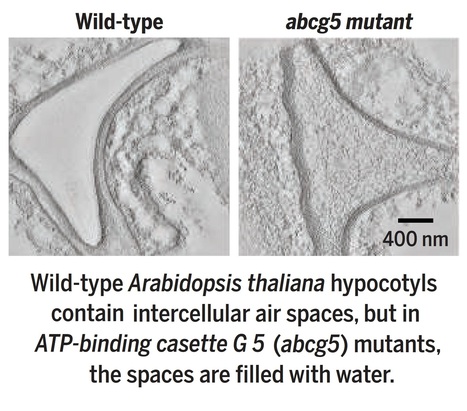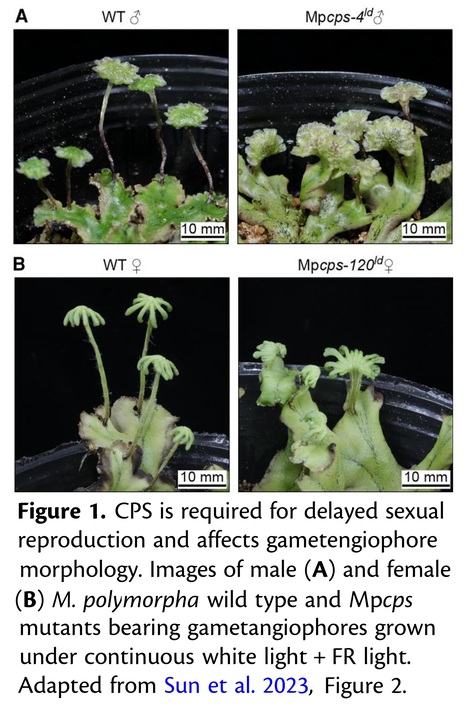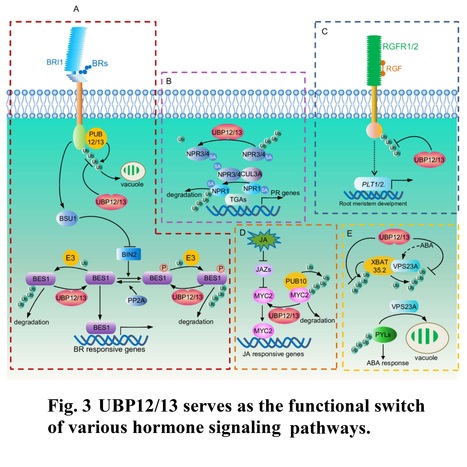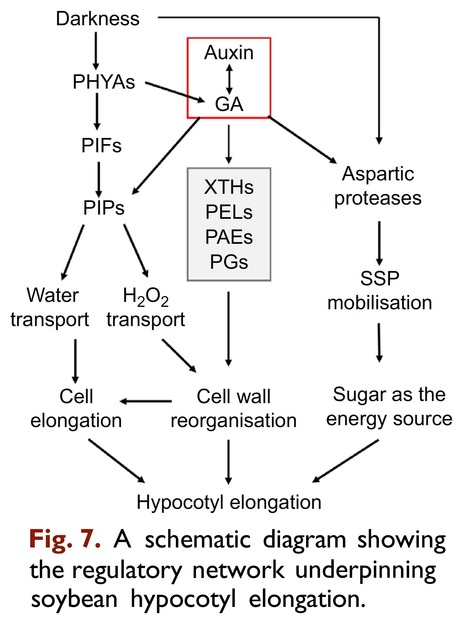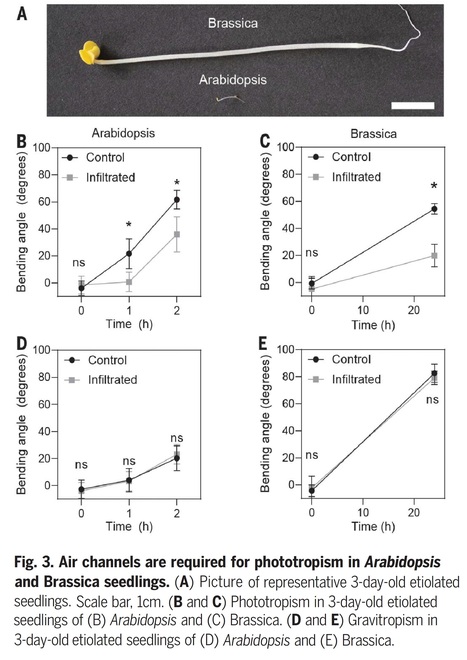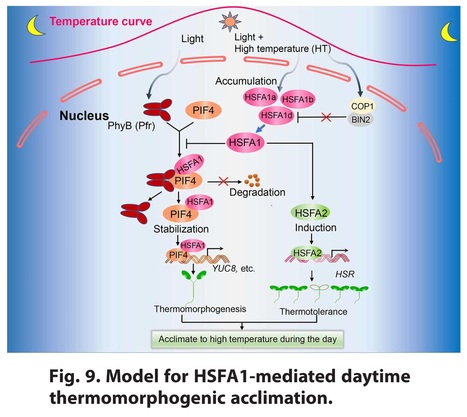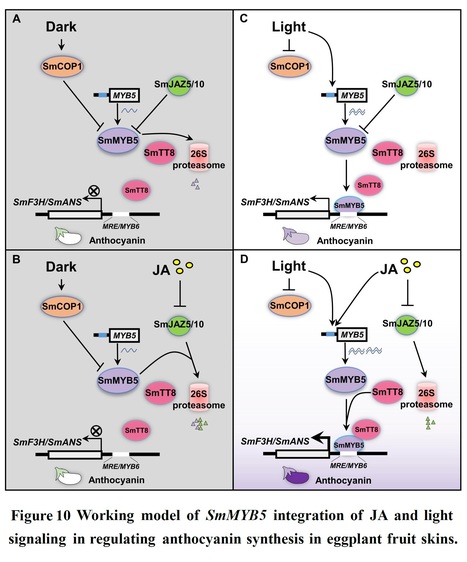 Your new post is loading...
 Your new post is loading...
Authors: Yan Yan, Haofei Luo, Yuwei Qin, Tingting Yan, Jinbu Jia, Yifeng Hou, Zhijian Liu, Jixian Zhai, Yanping Long, Xian Deng and Xiaofeng Cao.
PNAS (2024)
Significance: Photomorphogenesis is a pivotal stage in early seedling growth that begins when the shoot first emerges from the soil and is exposed to light. Here, we investigated the role of post-transcriptional splicing (PTS) in this developmental stage. By applying Nanopore sequencing of full-length nascent RNA, we found that thousands of genes undergo light-responsive PTS. We used snRNA-seq to characterize seedlings under continuous darkness, or after 1 or 6 h of light exposure, revealing that transcripts showing light-responsive PTS are specifically enriched in mesophyll cells. We identified the splicing factor AtPRMT5 and the E3 ubiquitin ligase COP1 as key regulators of these light-responsive PTS events. These findings uncover how cell type–specific regulation of PTS is essential for the onset of photomorphogenesis.
Abstract: "Light plays a central role in plant growth and development, providing an energy source and governing various aspects of plant morphology. Previous study showed that many polyadenylated full-length RNA molecules within the nucleus contain unspliced introns (post-transcriptionally spliced introns, PTS introns), which may play a role in rapidly responding to changes in environmental signals. However, the mechanism underlying post-transcriptional regulation during initial light exposure of young, etiolated seedlings remains elusive. In this study, we used FLEP-seq2, a Nanopore-based sequencing technique, to analyze nuclear RNAs in Arabidopsis (Arabidopsis thaliana) seedlings under different light conditions and found numerous light-responsive PTS introns. We also used single-nucleus RNA sequencing (snRNA-seq) to profile transcripts in single nucleus and investigate the distribution of light-responsive PTS introns across distinct cell types. We established that light-induced PTS introns are predominant in mesophyll cells during seedling de-etiolation following exposure of etiolated seedlings to light. We further demonstrated the involvement of the splicing-related factor A. thaliana PROTEIN ARGININE METHYLTRANSFERASE 5 (AtPRMT5), working in concert with the E3 ubiquitin ligase CONSTITUTIVE PHOTOMORPHOGENIC 1 (COP1), a critical repressor of light signaling pathways. We showed that these two proteins orchestrate light-induced PTS events in mesophyll cells and facilitate chloroplast development, photosynthesis, and morphogenesis in response to ever-changing light conditions. These findings provide crucial insights into the intricate mechanisms underlying plant acclimation to light at the cell-type level."
Authors: Zhuang Li, Xiangguang Lyu, Hongyu Li, Qichao Tu, Tao Zhao, Jun Liu and Bin Liu.
Nature Communications (2024)
Editor's view: This study provides insights into how shade induces leaf senescence in soybean. The reduction of blue light intensity deactivates GmCRY1s, leading to the degradation of GmRGAs and the upregulation of WRKY100, ultimately promoting leaf senescence.
Abstract: "Leaf senescence is a crucial trait that has a significant impact on crop quality and yield. Previous studies have demonstrated that light is a key factor in modulating the senescence process. However, the precise mechanism by which plants sense light and control senescence remains largely unknown, particularly in crop species. In this study, we reveal that the reduction in blue light under shading conditions can efficiently induce leaf senescence in soybean. The blue light receptors GmCRY1s rather than GmCRY2s, primarily regulate leaf senescence in response to blue light signals. Our results show that GmCRY1s interact with DELLA proteins under light-activated conditions, stabilizing them and consequently suppressing the transcription of GmWRKY100 to delay senescence. Conversely, LBL reduces the interaction between GmCRY1s and the DELLA proteins, leading to their degradation and premature senescence of leaves. Our findings suggest a GmCRY1s-GmDELLAs-GmWRKY100 regulatory cascade that is involved in mediating LBL-induced leaf senescence in soybean, providing insight into the mechanism of how light signals regulate leaf senescence. Additionally, we generate GmWRKY100 knockout soybeans that show delayed leaf senescence and improved yield under natural field conditions, indicating potential applications in enhancing soybean production by manipulating the leaf senescence trait."
Authors: Johanna Krahmer and Christian Fankhauser.
Annual Review of Plant Biology (2024)
Abstract: "The hypocotyl is the embryonic stem connecting the primary root to the cotyledons. Hypocotyl length varies tremendously depending on the conditions. This developmental plasticity and the simplicity of the organ explain its success as a model for growth regulation. Light and temperature are prominent growth-controlling cues, using shared signaling elements. Mechanisms controlling hypocotyl elongation in etiolated seedlings reaching the light differ from those in photoautotrophic seedlings. However, many common growth regulators intervene in both situations. Multiple photoreceptors including phytochromes, which also respond to temperature, control the activity of several transcription factors, thereby eliciting rapid transcriptional reprogramming. Hypocotyl growth often depends on sensing in green tissues and interorgan communication comprising auxin. Hypocotyl auxin, in conjunction with other hormones, determines epidermal cell elongation. Plants facing cues with opposite effects on growth control hypocotyl elongation through intricate mechanisms. We discuss the status of the field and end by highlighting open questions."
Authors: Xiuhong Yao, Ke Fang, Kang Qiao, Jiawei Xiong Jiayi Lan, Juan Chen, Yuang Tian, Xinke Kang, Wei Lei, Dawei Zhang and Honghui Lin.
Science Signaling (2024)
Editor's view: Seedlings elongate rapidly in the dark but slow their growth and open their cotyledons (embryonic leaves) after exposure to light. Yao et al. identified a network of light-regulated transcription factors that stimulate these changes in response to far-red light. Exposure of Arabidopsis seedlings to far-red light stimulated phytochrome A and the transcription factor HY5 to induce expression of the transcription factor ATAF1. Cooperation of ATAF1 and HY5 repressed the expression of genes that promote seedling elongation and maintain cotyledon closure. These findings elucidate a complex network of transcription factors that slow growth and stimulate cotyledon opening when seedlings reach light.
Abstract: "The opening of the embryonic leaves (cotyledons) as seedlings emerge from the dark soil into the light is crucial to ensure the survival of the plant. Seedlings that sprout in the dark elongate rapidly to reach light but keep their cotyledons closed. During de-etiolation, the transition from dark to light growth, elongation slows and the cotyledons open. Here, we report that the transcription factor ACTIVATING FACTOR1 (ATAF1) participates in de-etiolation and facilitates light-induced cotyledon opening. The transition from dark to light rapidly induced ATAF1 expression and ATAF1 accumulation in cotyledons. Seedlings lacking or overexpressing ATAF1 exhibited reduced or enhanced cotyledon opening, respectively, and transcriptomic analysis indicated that ATAF1 repressed the expression of genes associated with growth and cotyledon closure. The activation of the photoreceptor phytochrome A (phyA) by far-red light induced its association with the ATAF1 promoter and stimulation of ATAF1 expression. The transcription factor ELONGATED HYPOCOTYL5 (HY5), which is also activated in response far-red light, cooperated with phyA to induce ATAF1 expression. ATAF1 and HY5 interacted with one another and cooperatively repressed the expression of growth-promoting and cotyledon closure genes. Together, our study reveals a mechanism through which far-red light promotes cotyledon opening."
Authors: Pierre Gautrat, Sara Buti, Andrés Romanowski, Guido Buijs and Ronald Pierik.
bioRxiv (2023)
Abstract: "Plants growing at high densities can detect competitors through changes in the composition of light reflected by neighbours. In response to this far-red-enriched light, plants elicit adaptive shade avoidance responses for light capture, but these need to be balanced against other input signals, such as nutrient availability. Here, we used a combination of transcriptomics, growth assays and dedicated genetic and pharmacological interventions to demonstrate how Arabidopsis integrates light and nitrate signalling. We unveiled that nitrate modulates shade avoidance via a previously unknown shade response pathway that involves root-derived transZeatin (tZ). Under nitrate-sufficient conditions, tZ promotes hypocotyl elongation specifically in the presence of supplemental far-red light. This occurs via PIF transcription factors-dependent inhibition of type-A ARRs cytokinin response inhibitors. Our data thus reveal how plants co-regulate responses to shade cues with root-derived information about nutrient availability, and how they restrict responses to this information to specific light conditions in the shoot."
Author: Christopher Whitewoods
Science (2023)
Excerpts: "Decades of work has identified the molecular mechanisms that underlie phototropism (1, 2), but whether plants also physically alter beams of light to enhance their ability to respond was not known. On page 935 of this issue, Nawkar et al. (3) report that plants can use intercellular air spaces to actively modify the path of light and perform accurate phototropism. This finding highlights the importance of physical organ structure in environmental sensing and opens new avenues to understand the role of air spaces in other contexts. Nawkar et al. show that intercellular air spaces in the hypocotyl (embryonic stem) of the model plant Arabidopsis thaliana scatter light and are necessary for phototropism. To do this, they identified a mutant line of the plant with a transparent hypocotyl that does not bend toward light. In this mutant, imaging methods including transmission electron microscopy revealed that the intercellular spaces in the hypocotyl and roots that are normally filled with air are instead full of water (see the images ). These water-filled spaces allowed light to pass through the stem without scattering, making the stem appear transparent. Mutant plants responded normally in response to gravity, which shows that this is a specific response to light rather than a more general defect in environmental sensing or directional growth."
"The authors identified the causative locus in the hypocotyl air space mutant as ATP-BINDING CASETTE G 5 (ABCG5). ABCG5 is a member of a large family of transporters that act on a wide range of substrates (4), although the substrate for ABCG5 is unknown."
Author: Arpita Yadav
The Plant Cell (2023)
Excerpts: "Although the function of GAs in mediating light responses has been thoroughly investigated in angiosperms, its conservation across land plants is unclear. The presence of this pathway in extant bryophytes, such as the liverwort Marchantia polymorpha, would support the hypothesis that the function of GA in mediating light response has been conserved since the most recent common ancestor of the vascular and nonvascular plants that lived on lands more than 400 million years ago. In this issue, Rui Sun and colleagues (Sun et al. 2023) investigated the impact of gibberellin-related compounds on the response of M. polymorpha to FR light."
"Under conditions enriched with FR light, wild-type M. polymorpha plants displayed a growth pattern characterized by narrow and hyponastic thallus, along with the initiation of gametangiophore (sexual structures) formation. This was accompanied by an upregulation in the expression of genes involved in gibberellin biosynthesis and an accumulation of the GA precursor GA12. On the other hand, mutations in genes related to gibberellin biosynthesis, such as MpCPS, exhibited a wide and flat thallus and a delay in the formation of gametangiophores (Fig. 1). Introducing the GA precursor KA to the Mpcps mutants restored the wild-type phenotype in a dose-dependent manner. Interestingly, no active GAs from angiosperms could rescue the phenotype, suggesting that the mutant phenotypes were caused by a deficiency of KA-derived bioactive diterpenoid compound(s) referred to as GAMp."
"In the comparative analysis of GA-related diterpenoid biosynthesis in M. polymorpha and Physcomitrella patens, the authors observed conservation of components in the biosynthesis of KA. However, notable distinctions were identified in the synthesis of bioactive compounds derived from KA. GAs in vascular plants are detected through GID1 receptors. However, bryophytes do not possess these receptors, indicating distinct mechanisms for perceiving GAs and regulating responses to FR light. The hyponastic responses observed in M. polymorpha under FR light conditions, similar to A. thaliana and other land plants, are regulated by a single phytochrome (Mpphy) and a transcription factor, PHYTOCHROME-INTERACTING FACTOR (MpPIF), which is present in a single copy (Inoue et al. 2016, 2019). In this research, the authors found that the FR light-mediated biosynthesis of GAMp is also dependent on MpPIF."
Authors: Jayne Griffiths, Annalisa Rizza, Bijun Tang, Wolf B. Frommer and Alexander M. Jones.
bioRxiv (2023)
Abstract: "The phytohormone gibberellin (GA) is critical for environmentally sensitive plant development including germination, skotomorphogenesis and flowering. The FRET biosensor GIBBERELLIN PERCEPTION SENSOR1, which permits single-cell GA measurements in vivo, was previously used to observe a GA gradient correlated with cell length in dark-grown but not light-grown hypocotyls. We sought to understand how light signalling integrates into cellular GA regulation. Here we show how the E3 ligase COP1 and transcription factor HY5 play central roles in directing cellular GA distribution in skoto- and photomorphogenic hypocotyls, respectively. We demonstrate that the expression pattern of biosynthetic enzyme GA20ox1 is the key determinant of the GA gradient in dark-grown hypocotyls and is a target of COP1 signalling. We engineered a second generation GPS2 biosensor with improved orthogonality and reversibility to show the cellular pattern of GA depletion during the transition to growth in the light. This GA depletion partly explains the resetting of hypocotyl growth dynamics during photomorphogenesis. Achieving cell-level resolution has revealed how GA distributions link environmental conditions with morphology and morphological plasticity and the GPS2 biosensor is an ideal tool for GA studies in further conditions, organs and plant species."
Authors: Hanqian Feng, Jinjuan Tan and Zhiping Deng.
Journal of Experimental Botany (2023)
Abstract: "Ubiquitination, a vital post-translational modification in plants, plays a significant role in regulating protein activity, localization, and stability. This process occurs through a complex enzyme cascade that involves E1, E2, and E3 enzymes, leading to the covalent attachment of ubiquitin molecules to substrate proteins. Conversely, deubiquitinating enzymes (DUBs) work in opposition to this process by removing ubiquitin moieties. Despite extensive research on ubiquitination in plants, our understanding of the function of DUBs is still emerging. UBP12 and UBP13, two plant DUBs, have received much attention recently and are shown to play pivotal roles in hormone signaling, light perception, photoperiod responses, leaf development, senescence, and epigenetic transcriptional regulation. This review summarizes current knowledge about these two enzymes, highlighting the central role of deubiquitination in regulating the abundance and activity of critical regulators like receptor kinases and transcriptional factors during phytohormone and developmental signaling."
Authors: Xueliang Zhang, Zhikang Shen, Xiaohu Sun, Min Chen and Naichao Zhang.
Functional Plant Biology (2023)
Abstract: "Hypocotyl elongation directly affects the seedling establishment and soil-breaking after germination. In soybean (Glycine max), the molecular mechanisms regulating hypocotyl development remain largely elusive. To decipher the regulatory landscape, we conducted proteome and transcriptome analysis of soybean hypocotyl samples at different development stages. Our results showed that during hypocotyl development, many proteins were with extreme high translation efficiency (TE) and may act as regulators. These potential regulators include multiple peroxidases and cell wall reorganisation related enzymes. Peroxidases may produce ROS including H2O2. Interestingly, exogenous H2O2 application promoted hypocotyl elongation, supporting peroxidases as regulators of hypocotyl development. However, a vast variety of proteins were shown to be with dramatically changed TE during hypocotyl development, including multiple phytochromes, plasma membrane intrinsic proteins (PIPs) and aspartic proteases. Their potential roles in hypocotyl development were confirmed by that ectopic expression of GmPHYA1 and GmPIP1-6 in Arabidopsis thaliana affected hypocotyl elongation. In addition, the promoters of these potential regulatory genes contain multiple light/gibberellin/auxin responsive elements, while the expression of some members in hypocotyls was significantly regulated by light and exogenous auxin/gibberellin. Overall, our results revealed multiple novel regulatory factors of soybean hypocotyl elongation. Further research on these regulators may lead to new approvals to improve soybean hypocotyl traits."
Authors: Camila Caldana, Fernando Carrari, Alisdair R. Fernie and Arun Sampathkumar.
The Plant Journal (2023)
Significance Statement: How molecular and chemical events are spatiotemporally regulated to influence developmental processes is a fundamental question in biology. In this article we provide insights on studies that show interaction between metabolism and development and discuss how metabolic processes impact cellular processes.
Abstract: "Developmental transitions, occurring throughout the life cycle of plants, require precise regulation of metabolic processes to generate the energy and resources necessary for the committed growth processes. In parallel, the establishment of new cells, tissues, and even organs, alongside their differentiation provoke profound changes in metabolism. It is increasingly being recognized that there is a certain degree of feedback regulation between the components and products of metabolic pathways and developmental regulators. The generation of large-scale metabolomics datasets during developmental transitions, in combination with molecular genetic approaches has helped to further our knowledge on the functional importance of metabolic regulation of development. In this perspective article, we provide insights into studies that elucidate interactions between metabolism and development at the temporal and spatial scales. We additionally discuss how this influences cell growth-related processes. We also highlight how metabolic intermediates function as signaling molecules to direct plant development in response to changing internal and external conditions."
Authors: Yanna Xu, Congjun You, Changbin Xu, Chaofan Zhang, Xiaoli Hu, Xiaolong Li, Haijie Ma, Jinli Gong and Xuepeng Sun.
Postharvest Biology and Technology (2024)
Highlights: • Skin coloration of tomato fruit responds differentially to red and blue light. • Both lights promote biosynthesis of carotenoids and phytohormones. • Gene modules associated with carotenoid and hormone metabolism were identified. • Transcription factors as key regulators of the modules were uncovered. • A working model was proposed to depict the light regulation of fruit coloration.
Abstract: "Understanding how light regulates pigment composition and accumulation is crucial for postharvest management of fruit quality and nutritional value. In this study, we investigated the influence of light quality, specifically the blue and red lights, on coloration of tomato fruit. We show that both lights expedite the progress of skin coloration in tomato fruit by promoting chlorophyll degradation, stimulating carotenoid biosynthesis, accelerating plastid conversion, and enhancing plant hormone (i.e., abscisic acid and ethylene) biosynthesis. However, red light shows higher efficiency in inducing color transition compared with blue light. Gene expression network analysis unraveled several modules that are associated with carotenoid metabolism and hormone biosynthesis in response to light treatments, among which the transcription factors including WRKY20, MYB12, ARR11, NAC16, bHLH46, ZNF69, and MYB58 were identified as potential key regulators. Collectively, our data provide new threads on the regulation of fruit coloration by light quality and highlight the potential utility of red LED treatment to improve the color and quality of tomato fruit."
Authors: Taras Pasternak, Stefan Kircher, Klaus Palme and José Manuel Pérez-Pérez.
Planta (2023)
Main conclusion: Root development is regulated by sucrose and light during early seedling establishment through changes in the auxin response and chromatin topology.
Abstract: "Light is a key environmental signal that regulates plant growth and development. The impact of light on development is primarily analyzed in the above-ground tissues, but little is known about the mechanisms by which light shapes the architecture of underground roots. Our study shows that carbohydrate starvation during skotomorphogenesis is accompanied by compaction of nuclei in the root apical meristem, which prevents cell cycle progression and leads to irreversible root differentiation in the absence of external carbohydrates, as evidenced by the lack of DNA replication and increased numbers of nuclei with specific chromatin characteristics. In these conditions, induction of photomorphogenesis was unable to restore seedling growth, as overall root growth was compromised. The addition of carbohydrates, either locally or systemically by transferring seedlings to sugar-containing medium, led to the induction of adventitious root formation with rapid recovery of seedling growth. Conversely, transferring in vitro carbohydrate-grown seedlings from light to dark transiently promoted cell elongation and significantly reduced root meristem size, but did not primarily affect cell cycle kinetics. We show that, in the presence of sucrose, dark incubation does not affect zonation in the root apical meristem but leads to shortening of the proliferative and transition zones. Sugar starvation led to a rapid increase in lysine demethylation of histone H3 at position K9, which preceded a rapid decline in cell cycle activity and activation of cell differentiation. In conclusion, carbohydrates are required for cell cycle activity, epigenetics reprogramming and for postmitotic cell elongation and auxin-regulated response in the root apical meristem."
|
Authors: Yongfeng Gao, Zihao Chen, Qian Feng, Tao Long, Jihua Ding, Peng Shu, Heng Deng, Peizhi Yu, Wenrong Tan, Siqin Liu, Lucas Gutierrez Rodriguez, Lijun Wang, Víctor Resco de Dios and Yinan Yao.
The Plant Cell (2024)
Abstract: "Photoperiod is a crucial environmental cue for phenological responses, including growth cessation and winter dormancy in perennial woody plants. Two regulatory modules within the photoperiod pathway explain bud dormancy induction in poplar (Populus spp.): the circadian oscillator LATE ELONGATED HYPOCOTYL 2 (LHY2) and GIGANTEA-like genes (GIs) both regulate the key target for winter dormancy induction FLOWERING LOCUS T2 (FT2). However, modification of LHY2 and GIs cannot completely prevent growth cessation and bud set under short-day conditions, indicating that additional regulatory modules are likely involved. We identified PtoHY5a, an orthologs of the photomorphogenesis regulatory factor ELONGATED HYPOCOTYL 5 (HY5) in poplar (Populus tomentosa), that directly activates PtoFT2 expression and represses the circadian oscillation of LHY2, indirectly activating PtoFT2 expression. Thus, PtoHY5a suppresses short day-induced growth cessation and bud set. Accordingly, PtoHY5a knockout facilitates dormancy induction. PtoHY5a also inhibits bud-break in poplar by controlling gibberellic acid (GA) levels in apical buds. Additionally, PtoHY5a regulates the photoperiodic control of seasonal growth downstream of phytochrome PHYB2. Thus, PtoHY5a modulates seasonal growth in poplar by regulating the PtoPHYB2–PtoHY5a–PtoFT2 module to determine the onset of winter dormancy, and by fine-tuning GA levels to control bud-break."
Authors: Esther Cañibano, Daniela Soto-Gomez, Juan Carlos Oliveros, Clara Bourbousse and Sandra Fonseca.
bioRxiv (2024)
Abstract: "Driven by cell elongation, hypocotyl growth is tightly controlled by light and responds to external stimuli and endogenous hormonal pathways. Hypocotyls are known to be responsive to the stress signalling hormone abscisic acid (ABA) which effectively inhibits cell elongation, but how this regulation is connected to light responses and other endogenous hormonal pathways has been a subject of limited studies. Here, we show that whereas hypocotyl elongation is sensitive to ABA in light-grown seedlings, the hypocotyl of dark-grown etiolated seedlings is ABA-insensitive. In the dark, hypocotyl sensitivity to ABA is restored in the constitutive photomorphogenic pifq and cop1-4 mutants, suggesting that an active light signalling pathway is necessary for hypocotyl responsiveness to ABA. However, etiolated hypocotyls retain ABA responsiveness, as could be detected by the induction of ABI1 and RD29B transcripts in response to exogenous ABA, suggesting that inhibition of hypocotyl elongation mediated by ABA does not follows the canonical ABA signalling dependent on transcription. Here, using RNA-seq analysis we identified a number of ABA differentially expressed genes (DEGs) that correlate with ABA inhibition of hypocotyl elongation, specifically in dark-grown pifq or light-grown WT plants, and whose expression remains unchanged by ABA treatment in dark-grown WT plants. Among these DEGs we identified a number of genes playing a role in cell elongation directly at the level of the plasma membrane, as SAURs, ion transporters, auxin flux regulators, channels, and cell wall modification enzymes. The use of the auxin transport inhibitor, NPA, revealed that in the light auxin transport impairment renders hypocotyls insensitive to ABA in WT and pifq plants. Thus, in the light, hypocotyl responsiveness to ABA is dependent on auxin transport and independent of PIFs. In the dark, PIFs render hypocotyls insensitive to ABA, perhaps by regulating the expression of a number of ABA DEGs, a mechanism that could allow plants to prioritize the elongation towards light, avoiding to slow-down soil emergence that could be induced by ABA signalling in case of sudden reduction of soil moisture."
Authors: Ryo Tachibana, Susumu Abe, Momo Marugami, Ayumi Yamagami, Rino Akema, Takao Ohashi, Kaisei Nishida, Shohei Nosaki, Takuya Miyakawa, Masaru Tanokura, Jong-Myong Kim, Motoaki Seki, Takehito Inaba, Minami Matsui, Kentaro Ifuku, Tetsuo Kushiro, Tadao Asami & Takeshi Nakano
Nature Communications (2023)
Editor's view: The authors identify BPG4, a novel regulator of chloroplast development. BPG4 directly suppresses transcriptional activity of GLK to fine-tune photosynthesis associated nuclear gene expression, and regulates chloroplast development and homeostasis.
Abstract: "Chloroplast development adapts to the environment for performing suitable photosynthesis. Brassinosteroids (BRs), plant steroid hormones, have crucial effects on not only plant growth but also chloroplast development. However, the detailed molecular mechanisms of BR signaling in chloroplast development remain unclear. Here, we identify a regulator of chloroplast development, BPG4, involved in light and BR signaling. BPG4 interacts with GOLDEN2-LIKE (GLK) transcription factors that promote the expression of photosynthesis-associated nuclear genes (PhANGs), and suppresses their activities, thereby causing a decrease in the amounts of chlorophylls and the size of light-harvesting complexes. BPG4 expression is induced by BR deficiency and light, and is regulated by the circadian rhythm. BPG4 deficiency causes increased reactive oxygen species (ROS) generation and damage to photosynthetic activity under excessive high-light conditions. Our findings suggest that BPG4 acts as a chloroplast homeostasis factor by fine-tuning the expression of PhANGs, optimizing chloroplast development, and avoiding ROS generation."
Authors: Fereshteh Jafari, Baobao Wang, Haiyang Wang and Junjie Zou.
Journal of Integrative Plant Biology (2023)
Abstract: "Maize is a major staple crop widely used as food, animal feed, and raw materials in industrial production. High-density planting is a major factor contributing to the continuous increase of maize yield. However, high planting density usually triggers a shade avoidance response and causes increased plant height and ear height, resulting in lodging and yield loss. Reduced plant height and ear height, more erect leaf angle, reduced tassel branch number, earlier flowering, and strong root system architecture are five key morphological traits required for maize adaption to high-density planting. In this review, we summarize recent advances in deciphering the genetic and molecular mechanisms of maize involved in response to high-density planting. We also discuss some strategies for breeding advanced maize cultivars with superior performance under high-density planting conditions."
Authors: María Florencia Mammarella, Leandro Lucero, Nosheen Hussain, Aitor Muñoz-Lopez, Ying Huang, Lucia Ferrero, Guadalupe L Fernandez-Milmanda, Pablo Manavella, Moussa Benhamed, Martin Crespi, Carlos L. Ballare, José Gutiérrez Marcos, Pilar Cubas and Federico Ariel.
EMBO Journal (2023)
Synopsis: The Arabidopsis lncRNA APOLO influences chromatin architecture to regulate transcription of specific genes, including auxin-responsive genes which are involved in the plant's response to shade avoidance. Here, APOLO is shown to respond to changes in light by influencing transcription and plant behavior. APOLO modulates the expression of BRANCHED1 (BRC1), a master regulator of shoot branching in Arabidopsis, through chromatin looping around the BRC1 promoter. APOLO-mediated chromatin looping is influenced by changes in light exposure and regulates branching behavior. Low-red/far-red light ratio-mediated leaf hyponasty depends on APOLO regulation of auxin-related genes. In vitro-transcribed APOLO directly sprayed onto plants is sufficient to alter plant auxin homeostasis in response to light conditions.
Abstract: "The long noncoding RNA (lncRNA) AUXIN-REGULATED PROMOTER LOOP (APOLO) recognizes a subset of target loci across the Arabidopsis thaliana genome by forming RNA–DNA hybrids (R-loops) and modulating local three-dimensional chromatin conformation. Here, we show that APOLO regulates shade avoidance syndrome by dynamically modulating expression of key factors. In response to far-red (FR) light, expression of APOLO anti-correlates with that of its target BRANCHED1 (BRC1), a master regulator of shoot branching in Arabidopsis thaliana. APOLO deregulation results in BRC1 transcriptional repression and an increase in the number of branches. Accumulation of APOLO transcription fine-tunes the formation of a repressive chromatin loop encompassing the BRC1 promoter, which normally occurs only in leaves and in a late response to far-red light treatment in axillary buds. In addition, our data reveal that APOLO participates in leaf hyponasty, in agreement with its previously reported role in the control of auxin homeostasis through direct modulation of auxin synthesis gene YUCCA2, and auxin efflux genes PID and WAG2. We show that direct application of APOLO RNA to leaves results in a rapid increase in auxin signaling that is associated with changes in the plant response to far-red light. Collectively, our data support the view that lncRNAs coordinate shade avoidance syndrome in A. thaliana, and reveal their potential as exogenous bioactive molecules. Deploying exogenous RNAs that modulate plant–environment interactions may therefore become a new tool for sustainable agriculture."
Authors: Ganesh M. Nawkar, Martina Legris, Anupama Goyal, Emanuel Schmid-Siegert, Jérémy Fleury, Antonio Mucciolo, Damien De Bellis, Martine Trevisan, Andreas Schueler and Christian Fankhauser.
Science (2023)
Editor's view: As seedlings emerge, their embryonic stems unfold and extend as they grow toward light. Phototropin blue light receptors detect the gradient of light, thus allowing the direction of growth to be determined. Nawkar et al. found that mutation of a transporter protein, ABCG5, caused defective seedling phototropism (see the Perspective by Whitewoods). The authors found that air spaces between hypocotyl cells were impaired, preventing scattering of light across the tissue. Intercellular air spaces have been known to aid gas exchange and facilitate buoyancy in aquatic plants. The work here demonstrates an additional functional role for air spaces in setting up a light gradient and also provides insight into how they form.
Abstract: "In plants, light direction is perceived by the phototropin photoreceptors, which trigger directional growth responses known as phototropism. The formation of a phototropin activation gradient across a photosensitive organ initiates this response. However, the optical tissue properties that functionally contribute to phototropism remain unclear. In this work, we show that intercellular air channels limit light transmittance through various organs in several species. Air channels enhance light scattering in Arabidopsis hypocotyls, thereby steepening the light gradient. This is required for an efficient phototropic response in Arabidopsis and Brassica. We identified an embryonically expressed ABC transporter required for the presence of air channels in seedlings and a structure surrounding them. Our work provides insights into intercellular air space development or maintenance and identifies a mechanism of directional light sensing in plants."
Authors: Wenrong Tan, Junhua Chen, Xiaolan Yue, Shuli Chai, Wei Liu, Chenglin Li, Feng Yang, Yongfeng Gao, Lucas Gutiérrez Rodríguez, Víctor Resco de Dios, Dawei Zhang and Yinan Yao.
Science Advances (2023)
Abstract: "During summer, plants often experience increased light inputs and high temperatures, two major environmental factors with contrasting effects on thermomorphological traits. The integration of light and temperature signaling to control thermomorphogenesis in plants is critical for their acclimation in such conditions, but the underlying mechanisms remain largely unclear. We found that heat shock transcription factor 1d (HSFA1d) and its homologs are necessary for plant thermomorphogenesis during the day. In response to warm daytime temperature, HSFA1s markedly accumulate and move into the nucleus where they interact with phytochrome-interacting factor 4 (PIF4) and stabilize PIF4 by interfering with phytochrome B–PIF4 interaction. Moreover, we found that the HSFA1d nuclear localization under warm daytime temperature is mediated by constitutive photomorphogenic 1–repressed GSK3-like kinase BIN2. These results support a regulatory mechanism for thermomorphogenesis in the daytime mediated by the HSFA1s-PIF4 module and uncover HSFA1s as critical regulators integrating light and temperature signaling for a better acclimation of plants to the summer high temperature."
Authors: Shizhan Chen, Xiaocong Fan, Meifang Song, Shuaitao Yao, Tong Liu, Wusi Ding, Lei Liu, Menglan Zhang, Weimin Zhan, Lei Yan, Guanghua Sun, Hongdan Li, Lijian Wang, Kang Zhang, Xiaolin Jia, Qinghua Yang and Jianping Yang.
Plant Physiology (2023)
Abstract: "Maize (Zea mays L.) is one of the most important crops worldwide. Photoperiod, light quality, and light intensity in the environment can affect the growth, development, yield, and quality of maize. In Arabidopsis (Arabidopsis thaliana), cryptochromes are blue-light receptors that mediate the photocontrol of stem elongation, leaf expansion, shade tolerance, and photoperiodic flowering. However, the function of maize cryptochrome ZmCRY in maize architecture and photomorphogenic development remains largely elusive. The ZmCRY1b transgene product can activate the light signaling pathway in Arabidopsis and complement the etiolation phenotype of the cry1-304 mutant. Our findings show that the loss-of-function mutant of ZmCRY1b in maize exhibits more etiolation phenotypes under low blue light and appears slender in the field compared with wild-type plants. Under blue and white light, overexpression of ZmCRY1b in maize substantially inhibits seedling etiolation and shade response by enhancing protein accumulation of the bZIP transcription factors ELONGATED HYPOCOTYL 5 (ZmHY5) and ELONGATED HYPOCOTYL 5-LIKE (ZmHY5L), which directly upregulate the expression of genes encoding gibberellin (GA) 2-oxidase to deactivate GA and repress plant height. More interestingly, ZmCRY1b enhances lodging resistance by reducing plant and ear heights and promoting root growth in both inbred lines and hybrids. In conclusion, ZmCRY1b contributes blue-light signaling upon seedling de-etiolation and integrates light signals with the GA metabolic pathway in maize, resulting in lodging resistance and providing information for improving maize varieties."
Authors: Christopher J. Brooks, Hagop S. Atamian and Stacey L. Harmer.
PLoS Biology (2023)
Abstract: "Sunflowers are famous for their ability to track the sun throughout the day and then reorient at night to face east the following morning. This occurs by differential growth patterns, with the east sides of stems growing more during the day and the west sides of stems growing more at night. This process, termed heliotropism, is generally believed to be a specialized form of phototropism; however, the underlying mechanism is unknown. To better understand heliotropism, we compared gene expression patterns in plants undergoing phototropism in a controlled environment and in plants initiating and maintaining heliotropic growth in the field. We found the expected transcriptome signatures of phototropin-mediated phototropism in sunflower stems bending towards monochromatic blue light. Surprisingly, the expression patterns of these phototropism-regulated genes are quite different in heliotropic plants. Most genes rapidly induced during phototropism display only minor differences in expression across solar tracking stems. However, some genes that are both rapidly induced during phototropism and are implicated in growth responses to foliar shade are rapidly induced on the west sides of stems at the onset of heliotropism, suggesting a possible role for red light photoreceptors in solar tracking. To test the involvement of different photoreceptor signaling pathways in heliotropism, we modulated the light environment of plants initiating solar tracking. We found that depletion of either red and far-red light or blue light did not hinder the initiation or maintenance of heliotropism in the field. Together, our results suggest that the transcriptional regulation of heliotropism is distinct from phototropin-mediated phototropism and likely involves inputs from multiple light signaling pathways."
Authors: Blanca Jazmin Reyes-Hernández and Alexis Maizel.
Current Opinion in Plant Biology (2023)
Abstract: "Lateral root (LR) formation in Arabidopsis is a continuous, repetitive, post-embryonic process regulated by a series of coordinated events and tuned by the environment. It shapes the root system, enabling plants to efficiently explore soil resources and adapt to changing environmental conditions. Although the auxin-regulated modules responsible for LR morphogenesis and emergence are well documented, less is known about the initial priming. Priming is characterised by recurring peaks of auxin signalling, which, once memorised, earmark cells to form the new LR. We review the recent experimental and modelling approaches to understand the molecular processes underlying the recurring LR formation. We argue that the intermittent priming of LR results from interweaving the pattern of auxin flow and root growth together with an oscillatory auxin-modulated transcriptional mechanism and illustrate its long-range sugar-mediated tuning by light."
Authors: Shaohang Li, Yanxiao Dong, Dalu Li, Suli Shi, Na Zhao, Jielei Liao, Yang Liu and Huoying Chen.
Plant Physiology (2023)
Abstract: "Low light conditions severely suppress anthocyanin synthesis in fruit skins, leading to compromised fruit quality in eggplant (Solanum melongena L.) production. In this study, we found that exogenous methyl-jasmonate (MeJA) application can effectively rescue the poor coloration of the eggplant pericarp under low light conditions. However, the regulatory relationship between jasmonate and light signaling for regulating anthocyanin synthesis remains unclear. Here, we identified a JA-response factor, SmMYB5, as an anthocyanin positive regulator by applying RNA-sequencing, and characterization of transgenic plants. Firstly, we resolved that SmMYB5 can interact with TRANSPARENT TESTA8 (SmTT8), an anthocyanin-promoted BASIC HELIX-LOOP-HELIX (bHLH) transcription factor, to form the SmMYB5-SmTT8 complex and activate CHALCONE SYNTHASE (SmCHS), FLAVANONE-3-HYDROXYLASE (SmF3H) and ANTHOCYANIN SYNTHASE (SmANS) promoters by direct binding. Secondly, we revealed that JA signaling repressors JASMONATE ZIM DOMAIN5 (SmJAZ5) and SmJAZ10 can interfere with the stability and transcriptional activity of SmMYB5-SmTT8 by interacting with SmMYB5. JA can partially rescue the transcriptional activation of SmF3H and SmANS promoters by inducing SmJAZ5/10 degradation. Thirdly, we demonstrated that the protein abundance of SmMYB5 is regulated by light. CONSTITUTIVELY PHOTOMORPHOGENIC1 (SmCOP1) interacts with SmMYB5 to trigger SmMYB5 degradation via the 26S proteasome pathway. Finally, we delineated a light-dependent JA-SmMYB5 signaling pathway that promotes anthocyanin synthesis in eggplant fruit skins. These results provide insights into the mechanism of the integration of JA and light signals in regulating secondary metabolite synthesis in plants."
Authors: Xin Zhao, Wenwen Liu, Palinuer Aiwaili, Han Zhang, Yanjie Xu, Zhaoyu Gu, Junping Gao and Bo Hong.
Plant Physiology (2023)
One-sentence summary: Short days accelerate the juvenile-to-adult transition by increasing endogenous gibberellin biosynthesis and perception in chrysanthemum, leading to entry into floral transformation.
Abstract: "The gibberellins (GAs) receptor GA INSENSITIVE DWARF1 (GID1) plays a central role in GA signal perception and transduction. The typical photoperiodic plant chrysanthemum (Chrysanthemum morifolium) only flowers when grown in short-day photoperiods. In addition, chrysanthemum flowering is also controlled by the aging pathway, but whether and how GAs participate in photoperiod- and age-dependent regulation of flowering remain unknown. Here, we demonstrate that photoperiod affects CmGID1B expression in response to GAs and developmental age. Moreover, we identified PHOTOLYASE/BLUE LIGHT RECEPTOR2, an atypical photocleavage synthase, as a CRYPTOCHROME-INTERACTING bHLH1 interactor with which it forms a complex in response to short days to activate CmGID1B transcription. Knocking down CmGID1B raised endogenous bioactive GA contents and GA signal perception, in turn modulating the expression of the aging-related genes MicroRNA156 and SQUAMOSA PROMOTER BINDING PROTEIN-LIKE3. We propose that exposure to short days accelerates the juvenile-to-adult transition by increasing endogenous GA contents and response to GAs, leading to entry into floral transformation."
|




 Your new post is loading...
Your new post is loading...






